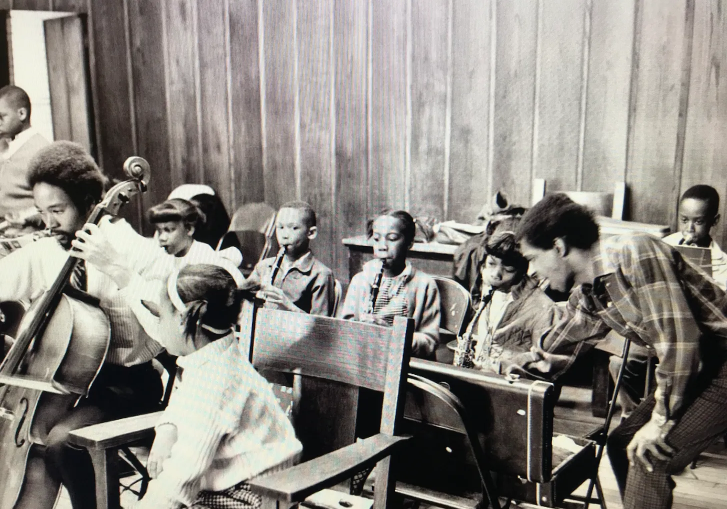Musical Organizations
Association for the Advancement of Creative Musicians
AACM members conduct free music lessons
The Association for the Advancement of Creative Musicians (AACM), was founded in 1965 in Chicago. It is a crucial example of Black musicians independently organizing and coming together to assert control over their artistic and economic destinies. The AACM was focused on the ideas of self-determination, collectivism, and artistic innovation. They were not just a performance group, but an institution that cultivated musicianship through free education programs, mentorship, and a commitment to experimental music. 1
The AACM’s commitments were very much in line with the broader Black Power movement. When asked whether the AACM had anything to do with Black Power, founder Muhal Richard Abrams responded: "Yes, it does in the sense that we intend to take over our own destinies, to be our own agents, and to play our own music." 2 This rejection of the narratives placed upon Black musicians was emblematic of the political struggle in which Black communities were seeking autonomy over their economic and cultural lives. In structure and rhetoric like this, the AACM directly challenged mainstream expectations of Black music and reflected the struggle for self-definition of Black communities in America.
Black Artists Group
The Black Artists Group (BAG) was formed in St. Louis in 1968. They were inspired by the Black Arts Movements, and specifically groups like the AACM. However, the BAG had a more holistic vision of Black creativity which included mediums such as music, theatre, poetry, and visual art 3. Members of the BAG, including Oliver Lake, Julius Hemphill, and Hamiet Bluiett all went on to be major forces in free-jazz (particularly through their involvement with the World Saxophone Quartet and the New York Loft Scene).
Because of its multidisciplinary approach, the BAG functioned more as a intellectual and creative hub than a music collective. In this hub, Black creatives of all backgrounds could thrive without having to rely on the mainstream institutions that often exploited or marginalized their work. Like the AACM, BAG sought to build an infrastructure where Black creativity could thrive on its own terms and not be tethered to white-dominated industries that dictated the boundaries and narratives surrounding Black expression.
Sun Ra Arkestra
Sun Ra’s Arkestra is another example of Black improvisational musicians challenging mainstream expectations through both musical innovation and independent organizing. Sun Ra was one of the most radical, influential thinkers in the history of Jazz. In the Arkestra, he built an entirely self-sufficient artistic community. The Arkestra was both a band and a way of life. It was a communal unit where members lived together, rehearsed constantly, and created a Afrocentric narrative surrounding their music and traditions. Sun Ra’s record label, El Saturn Records, demonstrated that Black artists could maintain full creative and financial control over their work 4.
Sun Ra was also known for bucking the conventions of Jazz. Not just musically like other Free Jazz musicians, but with his elaborate, theatrical performances that demanded attention. Sun Ra embodied Afrofuturism, and in doing so subverted mainstream narratives about Black culture and music. He created his own fiction around space and jetting away from Earth and the animosity it held for his people. In this way, and by creating his own model for music conceptualization, production and distribution, Sun Ra exemplified the kind of radical self-sufficiency that many Black movements sought to achieve 5.



